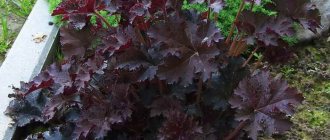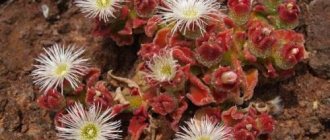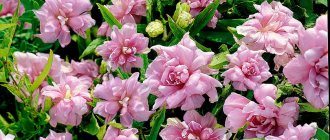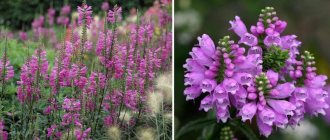When the orchard is already filled with juicy fruits, the main favorite of gardeners in the south is the bush hibiscus. You will see photos of various types and varieties below. We will also talk about care, reproduction, cultivation characteristics, and the variety of varieties of garden bush hibiscus. Few people will be indifferent to huge hibiscus flowers. This is an incredibly beautiful garden plant, even exotic in some ways.
What could be more attractive than flower beds decorating your garden? Of course, flowering trees and shrubs. Not many people know what hibiscus is. But almost all flower growers know what a Chinese rose is. But these plants are from the same family – malvaceae.
Garden bush hibiscus - types and varieties
When starting to write this article, I did not think that classifying garden hibiscus, dividing them into types and varieties would cause difficulties. But this turned out to be quite a difficult task. I have never found a clear systematization of species and varieties. But I can still share some information.
There are wild and cultivated species. There are annuals and perennials. Of these, tree, shrub, and herbaceous species can be distinguished.
Wikipedia, by the way, gives its classification of species:
- Hemp, or Kenaf (Hibiscus cannabinus) - used by the spinning industry of some tropical countries;
- Chinese, or Chinese rose (Hibiscus rosa-sinensis) - indoor culture;
- Rosella, or Sabdariffa or Sudanese rose (Hibiscus sabdariffa) - from the mallow family, common in tropical countries, originally bred in India;
- Syrian (Hibiscus syriacus) is a common perennial species in Russia for growing in open ground. Frost-resistant, perennial, shrubby;
- Trifoliate or Northern (Hibiscus syriacus) is an annual herbaceous plant growing on mountain slopes, along rivers and lakes in Asia, India, the Mediterranean, etc.
Separately, another species is mentioned separately - Swamp or Musk (Hibiscus moscheutos) - a perennial herbaceous plant, a favorite of gardeners in the south of Russia. In winter, the above-ground part dies off.
Let's try to figure out what types of hibiscus exist. Let's take as a basis the classification according to growth methods and forms of development: herbaceous, shrubby, tree-like.
- Herbaceous - a tall bush with strong upright branches, large leaves, large flowers. The diameter of the flower (depending on the variety) can reach 40 cm. The bush dies every year in the fall, and in the spring it again throws out young shoots.
Grassy
- Shrub - a slow-growing deciduous bush with many branches. Blooms profusely all season. Flowers are medium in size from 5 to 25 cm in diameter. By the way, all shrub species can be formed into one trunk, resulting in beautiful flowering trees.
Shrubby
- Tree-like - a single-trunked deciduous tree that can grow up to 5-6 meters in height. The whole season is covered with flowers up to 12 cm in diameter.
Treelike
A common feature of all varieties: the flower lasts only a day, but one faded bud is immediately replaced by a new one that has blossomed, so the flowering seems constant.
Now new varieties have appeared - flowers can remain fresh for more than one day. But it all depends on the degree of lighting. The sunnier place you choose for your pet, the longer the lifespan of one flower. But still, the flowering period is short - from one to 2-3 days.
Landscape designers love garden hibiscus of all types. City gardens and parks are often decorated with ornamental shrubs of various types of hibiscus. And in private backyards and summer cottages you can increasingly find herbaceous species.
general information
Hibiscus is the same hibiscus tea, the national symbol of Malaysia and the Chinese rose in one bottle. It belongs to the Malvaceae family and some varieties are even confused with ordinary mallows. Hibiscus flowers are large, colorful, graceful and have long, colorful corollas.
Hibiscus was grown in European botanical gardens back in the eighteenth century, and since then its popularity has not fallen. The diameter of the flowers reaches 16, and sometimes over 20 cm. The shrubs live up to thirty years and, once mature, cause virtually no trouble.
Hibiscus flowering lasts only a few days, but this is fully compensated by its lushness. If you properly care for the plant, it will grow buds again and again. In warm latitudes, most varieties are evergreen perennials that bloom all year round.
Photo: aquarium-fish-home.ru
Herbaceous garden bush hibiscus
These are hybrids that were bred by crossing three varieties of North American origin - holly, pink, red. This is a perennial that, after the ground part has withered, provided the root system is covered, can withstand frosts down to -30ºC.
The rhizome of one specimen is quite powerful and looks like a tuberous one. The bush blooms from mid-summer to late autumn. Ten or more flowers can bloom at the same time.
Herbaceous varieties are in great demand because of their large (up to 30-40 cm in diameter) bright colorful flowers (white, red, pink, burgundy, etc.), sometimes double.
The height of this plant can reach three meters. The branches manage to reach this length in one season.
Among the herbaceous plants, the most popular among gardeners are marsh plants. Why are they called that? Because for the first time, entire thickets of this incredibly beautiful plant were discovered in the swamps along the Mississippi River, where they are perennial. In our country they are also perennial, but with the above-ground part of the bush dying off in winter.
Bolotny
In flower beds, herbaceous varieties look great together with their low-growing neighbors. For example, in the center of the rose garden, your pet will be a majestic king.
Huge flowers the size of a plate will surprise not only you, but your guests, neighbors, and just passers-by.
Varieties of herbaceous hibiscus
The Copper King variety is a compact bush. The rounded compact shape is achieved by annual formation of no more than 120 cm in height. Dark green, lacy, shaped like maple, the leaves can change color, which depends on the ambient temperature. The flowers are large, up to 30 cm in diameter, the color of strawberry mousse - white and pink with bright pink stripes. The heart of the flower is purplish-red. Resistant to diseases.
Copper King
The Cranberry Crush variety grows as a rounded, lush shrub with greenery from the roots, 90-120 cm high. It has green, feathery foliage with purple veins. The flowers are large, up to 25 cm in diameter, of a rich burgundy color with dark stripes on the petals.
Cranberry Crash
The Old Yella variety is a strong bush with strong shoots up to 100-120 cm high, with greenery from the roots. The leaf is green, pinnate, maple-shaped, with a purple tint in sunlight. The flowers are huge, 30 cm in diameter, white or cream in color with a red core. The petals are wavy.
Old Yella
Separately, participants in various forums are discussing the garden yellow herbaceous hibiscus - this species has several varieties, but, as some gardeners claim, all of them can only be annuals! They write in plain text: “Don’t believe it if they try to sell you a perennial yellow, such a hybrid does not exist, although breeders are trying to achieve this. This species will have to be sown by seed every year.”
But, nevertheless, some amateur gardeners claim that they grow yellow perennials. Perhaps you, the readers, can clarify? If your garden is decorated with this flower, you have experience in caring for it, growing it, write a comment.
Pest and disease control
A sticky coating on the leaves most often indicates the appearance of aphids, and small cobwebs on the back side are a sure sign of a mite. Hibiscus is also eaten by whiteflies and scale insects, and scale insects like to settle on the branches. It is very important to remove all faded buds in a timely manner, because gall midges lay eggs in them over time.
The most common disease of hibiscus is non-infectious and infectious chlorosis. The first appears due to improper care and imbalance of beneficial elements, and the second due to a fungus or virus. Another common consequence of fungal infections is vascular wilt. In this case, you need to urgently cut off the diseased branches, including the healthy part, and treat them with fungicides.
Photo: sammedic.ru
Shrub hibiscus
Among the shrubs, the most popular is Syrian, which has many varieties. Its flowers are smaller in size than those of the herbaceous species, reaching a diameter of 12 cm. The colors are varied: the flowers are purple, white, red, and there are varieties with two-color colors.
The splendor of the flowers of some varieties is complemented by long pistils with fluffy stamens, which attract bees and butterflies.
With proper care, the bush is usually abundantly strewn with flowers and looks very delicate, although it grows slower than the herbaceous one. In a bright place protected from the wind and scorching sun, the bush can grow for up to 20 years.
The bush reaches a height of two to three meters, less often four to six, and a width of 1.5 meters.
But having acquired a young specimen, do not be tormented by the question: why does the hibiscus not bloom. The Syrian bush blooms only after 3-4 years.
Varieties of bush hibiscus
The Ardens variety is a perennial deciduous shrub that grows up to 2-3 meters in height. Easily formed like a standard tree. Dense flowering with rather large (up to 14 cm) double flowers of lavender or soft pink color.
Ardens
Variety Blue Satin is a perennial spreading deciduous shrub. The height can be up to 4-6 meters. They are often formed into a trunk to make the bush a compact tree, or one trunk, removing excess shoots in the first years of life. The flowers are large, 15 cm in diameter, blue, azure and cornflower blue. The depth of color depends on the lighting; the more light there is, the more saturated the color of the flowers.
Blue Satin
Botanical description
In Brazil, garden hibiscus is called princess earrings, in Malaysia it is a flower of love, in Hawaii it is a flower for women.
Tree-like garden hibiscus grows slowly, the height in the garden is no more than 2 meters.
Annual and perennial herbaceous species with small foliage that bloom in late summer are grown in the flower beds. General properties of all hibiscus:
- foliage is cuttings, notched, dark, shiny;
- funnel-shaped flowers are bright, large, located on the tops of young shoots;
- fruits in the form of boxes with five leaves.
The flowers have different colors, the petals are simple, semi-double, double, one- or two-color. There are varieties with a border around the edges of the petals and “eyes” in the centers of the flowers. Gardeners highly value varieties with blue and lavender flowers. All types of garden hibiscus are very beautiful.
tree hibiscus
Tree-like is an excellent solution for beginning flower growers - because it is quite unpretentious. The main advantage is that it winters well in the south, without requiring additional shelter, except in the first years. The tree differs from shrub species, only in appearance - it has one trunk, which can branch at a height of about half a meter. The photo below is a young four-year-old tree. This is its second flowering.
An adult plant can grow up to 5 meters tall, even higher.
Tree hibiscus in Sevastopol
The tree-like leaves are large, bright green, the flowers are medium-sized, brightly colored, they can also be double, two- or three-colored.
Planting seedlings
The seedlings do not need any additional procedures; you can safely transplant them into a plot or into a pot of suitable size.
How to plant hibiscus:
- Prepare the soil. Dig up the area in advance, adding peat and sand for digging. You can also add organic matter - humus and compost. For the tub, prepare the mixture. For example, this composition:
- garden soil - 2 parts;
- peat - 4 parts;
- sand - 1 part.
- Dig a hole for planting. Its volume should be such that the seedling fits comfortably in it (about twice the size of the roots). The intervals between adjacent pits are 1.5-2 m.
- Prepare the hole for planting. Place a 10-15 cm layer of drainage on the bottom. This can be pebbles or small crushed stone. Pour sand onto the drainage, then compost.
- Plant a seedling. Carefully remove the seedling from the planting pot. Place the plants in the center of the hole, strictly vertically, and carefully sprinkle its roots with the soil mixture prepared in advance. Make it from a mixture of sand, peat and the top layer of earth removed when digging a hole.
- Complete landing. Form a circle near the trunk - a recess in which water will accumulate during watering.
- Watering. Pour 10 liters of water into the furrow around the seedling.
- Trimming. Immediately after planting, all shoots are shortened by half their length.
Additionally, watch the video instructions on planting hibiscus in the garden:
The root collar of a hibiscus seedling should be slightly below ground level.
If you are going to plant hibiscus in the garden, you usually use purchased planting material for this purpose. Plants can serve as a wonderful decoration for a summer cottage. If winters are harsh, the plants are transplanted into tubs and moved to the basement. Or they carefully insulate the plant.
How to care for garden hibiscus
Any variety of this plant loves sun or bright light. Care is not difficult - timely watering, weeding, regular fertilizing with nitrogen or phosphorus fertilizers at least monthly. When it’s hot, you should avoid fertilizing at the roots; it’s better to spray nutritious fertilizers on the leaves.
Closer to autumn, it is necessary to apply potassium fertilizers, stopping nitrogen or phosphorus fertilizing, this will help prepare for wintering.
It is worth noting that all garden hibiscus love rotted needles. It can be added to the planting hole when transplanting or planting seedlings, and it can also be used to mulch the rhizome area.
Many gardeners love to pamper their plants with a summer foliage shower, and Hibiscus will not refuse this pleasure. The main thing to remember is that you can carry out “water procedures” only closer to sunset, when the sun no longer burns the leaves.
An alarming sign may be the simultaneous wilting of all flowers - the plant does not have enough moisture! Urgent, abundant watering will help to revive.
To protect against your pet’s main enemy, aphids, it is recommended to plant lavender bushes nearby, the aroma of which will repel pests.
Herbaceous and some shrubby varieties require shelter for the winter, so many gardeners prefer tree-like representatives of the genus because of their ability to delight with their beauty for many years without special care and preservation of pets in winter.
It is worth paying attention to the features of caring for different types.
Features of caring for herbaceous hibiscus
Watering, fertilizing, weeding, as with all species.
When autumn comes, the stem, leaves, and wilted flowers die. Nutrients from them are gradually absorbed by the root system. This makes it more developed, stronger, and makes it easier to endure frosty winters.
This is why you should not trim the stems of herbaceous species before they have completely dried out. In the south, where there is often no natural cover in the form of snow, an artificial one should be properly created.
The first thing we do is: cut off the shrunken aerial part, water it well, loosen it, and hill up the rhizome area. You can sprinkle with humus or mulch. Sawdust, fallen leaves, dry grass, and pine litter are suitable. If these are pine needles, then in the spring you can not remove them, but leave them on top, lightly mixing them with the soil by loosening them.
The resulting hummock should be covered on top with a white soft covering material, pressing it with stones or branches, building a kind of hut. When the frosts have passed, carefully free the plant stumps from the insulating cushion, being careful not to damage the buds. After all, already in May, young shoots appear, the tops of which are advised to be pinched for splendor.
Every three years it is necessary to divide the rhizome of the herbaceous hibiscus so that its flowering does not weaken or become smaller. After all, every season the number of shoots triples. The struggle for nutrients and moisture becomes more difficult. In the first year of life, the number of main shoots is one, in the second there are two to nine, usually five, but after three years there are three times as many. The time comes to divide the bush, which, by the way, is one of the ways to reproduce it.
Caring for Syrian Hibiscus
An adult shrub tolerates our Kuban winter well, and it is better to wrap the branches of a young plant (1-2 years old) with white covering material, and sprinkle the rhizome area with humus or mulch thoroughly. The root cover layer must be at least 15 cm high. Don't forget to free the plant from it in the spring!
The Syrian species wakes up quite late, don’t be scared - it should be like this, it’s just a certain feature of it.
The shrub loves phosphorus fertilizers (for example, Bud), which activate flowering. Closer to autumn, you need to start introducing potassium preparations to prepare the bush for wintering. Tree care differs only in that it does not need to be covered in winter. The exception is young seedlings, which should still be covered for the first 1-2 winters.
Important care points
When caring for bush hibiscus, you should adhere to the following rules:
- find him a good place;
- make quality soil;
- ensure the correct watering and fertilizing regime;
- carry out pruning in a timely manner.
What conditions are necessary to grow a flower?
Hibiscus bush is a rather whimsical plant that requires care. If you create comfortable conditions for it to grow, it will delight you with thick, long-lasting and abundant flowering.
What watering regime does the plant need?
Hibiscus grows well in high humidity. Therefore, in hot summers it is recommended to regularly spray it with warm water. It is advisable to carry out this procedure twice a day (morning and evening).
In spring and autumn, you don’t have to spray the plant or do it extremely rarely once every few days.
Attention: lack of moisture causes hibiscus leaves to wilt and fall off.
The plant is watered abundantly in summer. But at the same time, it is worth making sure that the soil does not become waterlogged. Otherwise, this will lead to rotting of the root system. It is best to water the flower with spring or settled water at room temperature. Do not use chlorinated tap water. This will cause the leaves to turn yellow.
How to prune correctly
Garden hibiscus need regular pruning and crown shaping. When pruning in spring or fall, it is important to remove all damaged branches. To make the bush more powerful and lush, it is recommended to remove young shoots from it.
Attention : if the bush has grown too tall, it can be trimmed to the height you need. At the same time, the plant will begin to actively sprout side shoots, which will give it a lush and elegant appearance.
The nuances of transplantation
If it is necessary to transplant the plant to a new location, this should be done in early spring after pruning, but also before the plant begins to flower. After transplantation, hibiscus needs abundant watering.
How does hibiscus reproduce?
It depends on the species. For example, tree varieties can only be propagated by cuttings, grafting, or seeds.
Shrubs, in addition to cuttings, grafting, and sowing seeds, can be propagated by layering.
Herbaceous plants can most easily be propagated by dividing the bush, but the above methods of cuttings and sowing seeds are also inherent in them.
Propagation by seeds is not difficult: it is done like any other sowing without any special tricks.
Work begins from January to March. First, it is recommended to soak the seeds for 10-12 hours in Epin solution. After this, rinse them with a weak solution of potassium permanganate.
For sowing you will need a container, a mixture of sand and peat, as well as a shelter (glass, polyethylene or cling film). The soaked seeds are sown in moist soil and covered. To ensure that the seedlings do not take long to emerge, the temperature should be maintained at around +25ºС. Also, do not forget to ventilate the container with crops, remove drops of condensation, and, if necessary, moisten the soil surface. After the seedlings have leaves, they can be planted in separate pots.
And in May, stronger seedlings are moved to a permanent place, and their weaker counterparts are moved to a temporary place - for growing.
When propagated by seeds, garden hibiscus will bloom for 3-4 seasons. Please note that it may not retain the decorative features of its parent. Therefore, propagation by seeds is not the best way to acquire a flower with exactly the properties that you like so much.
Propagation by cuttings is the most popular method among hobbyists. Can be produced in two ways.
- Cuttings with 3-4 buds cut in summer are immersed in water with the addition of Kornevin or another root system growth stimulator. After the roots appear, the cuttings are planted first in containers with peat soil for the winter, and in the spring - in open ground.
- Cuttings with 3-4 buds cut in summer are treated with a root growth stimulator in the same way as in the first method. But after this they are immediately planted in greenhouse containers with moist peat for rooting. Cuttings that have given roots are planted in pots for the winter, and in the spring they are planted in open ground.
When cuttings, there is a high probability that your pet will delight you with its flowering in the first year.
Propagation of garden hibiscus by dividing the bush is more suitable for herbaceous varieties. By the way, dividing the rhizome is a necessary technique for caring for herbaceous species to maintain high-quality flowering. This is one of the fastest, most convenient methods of reproduction.
In early spring, carefully dig up a 3-4 year old bush with a pitchfork and divide the rhizome with a knife or shovel. As a rule: one trunk - one separate plant. When dividing older bushes, 2-3 trunks are allowed per new specimen.
Sprinkle the sections with ash or crushed coal.
The resulting parts of the rhizome should be planted immediately. Well-watered planting holes with nutrient soil must be prepared in advance.
We fill the rhizomes with soil, compact the surface, and water again. After two weeks, you can carry out the first nitrogen fertilizing. With this care, separated bushes quickly sprout and delight their owners with flowering already in the first season after planting.
Reproduction by layering and the grafting method should be left to professionals, since these methods will require not only skills and knowledge, but also special tools, patience, composure, which are not always compatible with amateur gardeners. Especially when you need fast, reliable results.
Cuttings
Preparations for propagation by cuttings begin in the summer. First, plant cuttings are cut with 2-3 internodes. The sections made below are moistened in a growth stimulator and placed in greenhouses with a peat substrate. If you organize heating, it will be just great. It will take a month for full rooting; they are transplanted into pots. The formed bush is transplanted into the ground. By the way, if the hibiscus is formed from a cutting, it will bloom in the first year.
Hibiscus cuttings
Pruning hibiscus in autumn or spring, when is best?
It is important to know how pruning affects garden hibiscus, when to do it, and whether it is needed at all.
They say that young bushes should not be pruned. But that's not true. Needs to be trimmed! You need to start doing this as early as possible in order to give the plant shape, splendor, and increase flowering. After all, flower buds are formed only on young shoots.
Regular spring pruning is essential annual maintenance. It is also called hygienic or stimulating. It is recommended to carry out such pruning starting in February, until the bushes or trees wake up and until sap flow begins. Don’t be afraid to cut off the excess; last year’s shoots need to be mercilessly shortened by 1/3 of their length. Your pet will thank you with an abundance of flower buds. Anti-aging pruning of hibiscus in the fall is carried out on adult specimens. For example, your bush has reached a huge size or has become too thick. Cut out old dry branches, thin out the plant, leaving only the main skeletal ones.
Landscape designers advise leaving the central branch longer than the others. The crown shape will be more attractive.
For a tree-like representative, you can shape the crown by pruning, for example, make it spherical.
Regular anti-aging pruning (once every 3 years) will strengthen the skeleton of a shrub or tree.
What is hibiscus, the types of which were described above, you learned, got acquainted with the rules of caring for it, and the features of pruning. Now you can decide which variety your garden is missing and feel free to buy yourself a Chinese beauty.
Planting in a pot
To transplant a seedling into a new container, you need to select a voluminous pot - its diameter should exceed the previous one by 4-5 cm.
The procedure for planting (transferring) hibiscus seedlings:
- Place a layer of expanded clay at the bottom of the pot, and then add some soil. Add some charcoal to it.
- Water the seedling so that the flower is removed from the planting container without damage.
- Remove the seedling from the pot by tapping its walls.
- Place the seedling along with a lump of soil in a new pot so that it sinks a little. This will allow you to add fresh soil after planting.
- Fill the root ball with soil, gently tamping it down with your fingers.
- Place a support. For example, a wooden stick. Tie a plant to it. This will not only support the hibiscus, but will also prevent the pot from tilting and falling over.
- Generously water the planted seedling and cover the pot with film. This will allow the plant to take root faster and better after moving to a new container.
- Using a sharp garden knife, trim the branches to form a compact plant.
When the plant takes root, after a couple of days, the film is removed and it is grown, providing care - watering, fertilizing, etc. The pot is placed in a sunny place and provides fresh air to the flower.
Transplanting into a pot is carried out according to the same scheme, but the pot is filled with soil mixture at least 2/3. Then the flower is planted and its roots are covered with soil.
Hibiscus - signs, superstitions, traditions
There are also interesting facts that cannot be ignored.
This flower is said to have magical powers.
Someone calls it the flower of love - supposedly it gives a huge amount of energy that can resurrect a departed love or ignite a new one in the family where it grows.
Oddly enough, there is a scientific explanation for this: the nectar of the flower is an aphrodisiac, so it may well strengthen family relationships.
And doctors say that everyone should have hibiscus at home or in the garden, the beneficial properties of which lie in its exquisite aroma, containing phytoncides that suppress some carcinogens.
Well, the second loud popular name is garden hibiscus - the flower of death. Why? There are several reasons.
There is a legend that if a hibiscus blooms at the wrong time and gets out of rhythm, then you are in for trouble.
Also, a withering, drying plant supposedly portends a serious illness to one of the family members where it grows.
All this, of course, is superstition. Believe it or not is everyone's business.
No matter what superstitions tell us, it is impossible to refuse to grow a beautiful flower.
There are interesting traditions associated with hibiscus in different countries of the world. It is very interesting. For example, this plant is the national flower of several countries - Haiti, South Korea, Malaysia.
And the Filipinos use it to make the base for soap bubbles, crushing foliage and flowers to obtain a sticky liquid.
The hibiscus flower is traditionally worn on the head of Hawaiian girls and women. Moreover, if the flower is in the hair on the left, it means that the woman is not free. And if the flower is on the right, then this person is open to relationships.
Plant a bush garden hibiscus! Care and reproduction does not require much effort. There are a huge number of species and varieties. The color scheme will satisfy even the most demanding landscape designer. This wonderful plant will decorate your garden for many years, making it unique and amazing.
Where does it grow
Hibiscus is a heat-loving plant and is widespread in countries with tropical and subtropical climates. Some species are also found in temperate latitudes. Representatives of this genus can be found in a variety of countries and continents.
Hibiscus grows mainly in Africa, North and South America, and Europe. In Russia they can be seen in the Caucasus, Crimea and the Far East. But Europeans first encountered this plant in the Hawaiian Islands, from where they brought it first to Europe and then to America.
Garden hibiscus - photo
Summer Storm
Fire ball
Royal James
Author: Anna Pasechnik
Nutrition
Photo of an ibis in the desert
The diet of ibises consists of insects and small vertebrates. Birds hunt for mollusks, crustaceans, and larvae. Adults sometimes feast on larger prey - fish, eggs of small birds, frogs. Land ibises catch lizards, mice and earthworms. If possible, they eat beetles, snails, slugs, spiders and locusts.
In times of famine, ibises do not disdain to feed on carrion or the leftover food of predatory animals.
Lifestyle
A flock of ibises in the sky
Ibises are flocking birds. They live in colonies of 100-150 pairs. During nomadic migration, bird families unite into a huge flock, which numbers up to 1 million individuals. Birds fly together and create so-called “bird markets” in rest areas. Ibises are calm, peace-loving birds. They accept other birds into their flocks, for example, spoonbills, cormorants, herons. They all fly along the same route, and then also return home together. Thanks to their powerful long wings, ibises fly quickly and well. In one day they cover a distance of several hundred kilometers.
Photo of ibis
Ibises are diurnal. During daylight hours they hunt, leisurely wandering through shallow water and picking mud with their beaks in search of crustaceans or slugs. Having caught the prey, the bird makes a sharp swing of its head, picking up the food with its beak and swallowing it whole. Ibises are cautious birds. Sensing danger, they make a sharp flap of their wings and rise into the air with lightning speed, hiding from the enemy in the crown of trees or bushes. At night, ibises climb into their nests and rest.











